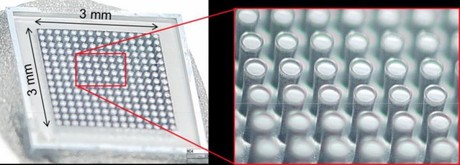3D microbatteries to help power the Internet of Things

As electronic devices become tinier and skinnier without reducing their power and energy demands, they challenge engineers to design batteries that can fit into smaller and smaller spaces without compromising on performance. Now, researchers from the University of California, Los Angeles (UCLA) have used non-traditional techniques to fashion a powerful 3D lithium-ion battery with a footprint on the order of 100 grains of salt.
“Three-dimensional (3D) microbatteries offer an opportunity to provide mobile power at dimensions that are comparable with those of the actuators, sensors, and other internet-connected devices that constitute the internet of things (IoT),” the researchers explained in the journal Joule. The catch, they said, is that these batteries need to be shaped a certain way.
“For small sensors, you need to redesign the battery to be like a skyscraper in New York instead of a ranch house in California,” said Professor Bruce Dunn, senior author on the study.
Even the most innovative two-dimensional batteries are limited in the shapes they can take — the basic battery takes a slice of anode and a slice of cathode and packs an ion-conducting electrolyte between the two to complete the circuit. On the other hand, there are, in principle, innumerable ways to craft a 3D anode and a 3D cathode that snap together like puzzle pieces (still necessarily separated by a small amount of electrolyte).
The set-up chosen by Professor Dunn’s group is called a ‘concentric-tube’ design, where an array of evenly spaced anode posts are covered uniformly by a thin layer of a photo-patternable polymer electrolyte and the region between the posts is filled with the cathode material. Yet despite this apparent simplicity, many researchers have only been able to build half of a 3D battery, creating anodes and cathodes that are stable on their own but fail when trying to assemble these electrodes into one functional battery. Meanwhile, nearly all of the 3D batteries which have been assembled have not been significantly better than ordinary two-dimensional versions.
Dunn and his team overcame these hurdles by taking methods normally used to make semiconductors and modifying them to carve silicon into a grid of precisely spaced cylinders that they wanted for the anode. According to Professor Dunn, “That’s something the battery world just does not do.”
To complete the battery, the team applied thin layers of electrolyte to the silicon structure and poured in a standard lithium-ion cathode material, using the anode as a mould to ensure that the two halves would fit together just right. The resulting battery achieved an energy density of 5.2 mWh/cm2 — among the highest reported for a 3D battery — while occupying a miniscule 0.09 cm2 footprint and withstanding 100 cycles of charging and discharging.
Professor Dunn claims the 3D battery has not yet reached its full potential, as he hopes that he and his team can boost its energy density with further tuning of battery components and assembly.
“Another challenge with batteries is always the packaging,” he said. “You need to seal them up, keep them small and make sure they function just as well in the real world as in the glovebox.”
Predictive AI model enhances solid-state battery design
ECU researchers are working on ways to make solid-state batteries more reliable with the help of...
Boosting performance of aqueous zinc–iodine batteries
Engineers from the University of Adelaide have enhanced aqueous zinc–iodine batteries using...
Sodium-ion battery breakthrough boosts energy storage
Scientists have discovered that leaving water inside a key material, rather than removing it,...




